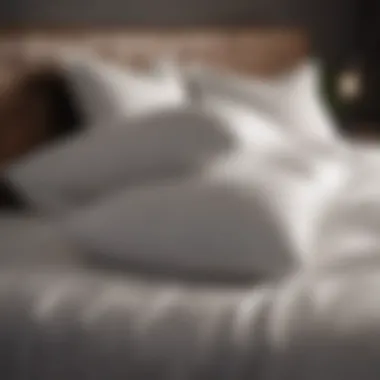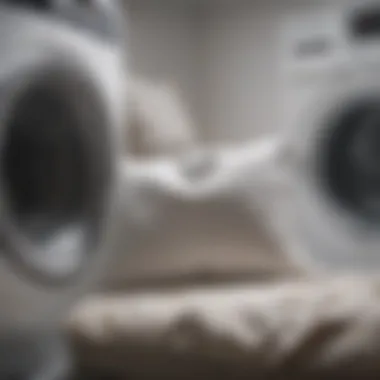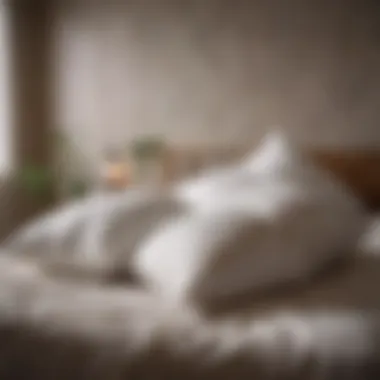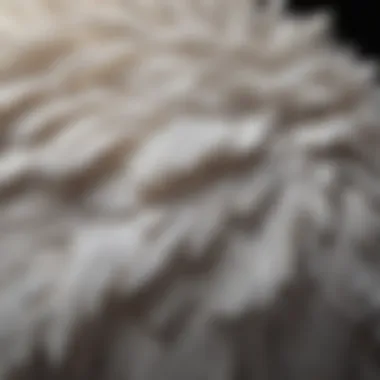How to Properly Wash Down Pillows for Longevity


Intro
W washing down pillows isn’t just about throwing them in the wash and hoping for the best. It can be a bit more complicated than that, yet understanding the process is crucial to maintain their comfort and longevity. Down pillows, made from the soft under-feathers of ducks or geese, require specific attention and care. This guide aims to equip you with practical knowledge and actionable steps to keep your pillows feeling plush and fresh.
Maintaining these luxurious bedding items not only enhances your sleeping experience but also contributes to a cleaner sleep environment. Over time, down pillows can accumulate oils, dust mites, and allergens, making regular washing essential. However, it’s crucial to employ the right techniques to avoid damaging them.
In the upcoming sections, we’ll cover everything from preparation to the cleaning methods and, importantly, the post-wash care necessary to preserves the integrity of your pillows. If you’re eager to keep your down pillows in peak form, then keep reading as we break down each step.
Understanding Down Pillows
When it comes to creating a cozy and inviting sleep space, down pillows often reign supreme. They are not just decorative items; they significantly affect the quality of our sleep. Understanding what down pillows are, their benefits, and the common issues they might present can remove a lot of guesswork when it comes to their care.
What are Down Pillows?
Down pillows are stuffed with the soft, fluffy undercoating found beneath the feathers of ducks or geese. Unlike synthetic materials, the natural fibers in down pillows allow for excellent insulation and breathability. They adapt to the shape of your head and neck, providing a plush yet supportive sleeping surface. It's like sleeping on a little cloud each night. While some people may opt for feather pillows, which contain the outer feathers of the birds, down pillows usually offer a superior comfort level due to their luxurious fill.
Benefits of Down Pillows
The benefits of down pillows are numerous, sparking affection among bedding aficionados:
- Comfort: They contour to your body, reducing pressure points and promoting a more restful sleep.
- Temperature Regulation: Down has natural insulating properties, which means it can help you stay warm in winter, yet remains breathable during hot nights.
- Durability: With the right care, down pillows can last for years. They generally retain their shape well over time when compared to synthetic alternatives.
- Lightweight: Due to their fluffy nature, down pillows are lightweight, making them easy to fluff and shift during the night.
"A good pillow can transform your sleep, turning restless nights into restful slumbers."
Common Issues with Down Pillows
While they offer a wonderful sleep experience, down pillows aren’t without their own set of challenges. Users should be aware of:
- Clumping: Over time, the down can cluster together, which can lead to uneven support. Regular fluffing can help mitigate this issue.
- Odor: New down pillows sometimes carry an odor from natural oils. Washing and airing them out usually help.
- Allergies: Some individuals may be sensitive or allergic to down, which can cause discomfort or waking up with a stuffy nose. Hypoallergenic options are available for those concerns.
- Maintenance: They require special care when cleaning. Readily catching the attention in washing machines, cleaning them improperly can damage the pillows and diminish their fluffiness.
Understanding these aspects makes it easier to appreciate down pillows, and it allows for informed decisions on cleaning and maintenance. In the following sections, we'll discuss how to best prepare for washing these luxuriously comfortable pillows so they can continue to provide the support and restful sleep we crave.
Preparing to Wash
Preparing to wash your down pillows is a crucial step that sets the stage for a successful and effective cleaning process. Taking the time to prepare ensures not only the longevity of your pillows but also guarantees a thorough cleaning without any damage. This section explores the importance of preparation, from checking care labels to gathering supplies.
Reading Care Labels
Reading care labels might seem trivial, but it's a game changer when it comes to washing down pillows. These labels provide vital instructions tailored to the specific materials used in your pillows. Ignoring them can lead to all sorts of headaches, from shrinkage to loss of fluffiness. The care label typically mentions the recommended washing method, drying instructions, and even the right products to use.
When you take the time to closely examine these labels, you can identify whether your pillows are machine washable or if they require hand washing. Plus, some labels suggest temperatures that help maintain the integrity of the down filling. So, a little bit of reading now can save a world of trouble later.
Gathering Necessary Supplies
A successful washing endeavor relies heavily on having the right tools at your fingertips. Gathering necessary supplies is a foundational step that prevents any last-minute scrambles.
Detergent selection
Selecting the right detergent is paramount. Not all detergents are created equal, especially when dealing with down pillows. It's advisable to choose a detergent that is free from harsh chemicals and additives – think "gentle" and "hypoallergenic."
The key characteristic of such a detergent is its ability to clean thoroughly without compromising the delicate structure of the down feathers. This makes it a beneficial choice for washing down pillows. Using a standard detergent can strip the feathers of their natural oils, leading to a flat and lifeless pillow. A specialized down detergent retains softness while ensuring effective cleaning.


Moreover, consider products that break down oils and perspiration effectively, as these are common culprits in creating an unpleasant smell. Achieving a balance between cleaning power and feather care is essential for the longevity of your pillows.
Drying aids
Once your pillows are clean, the drying process begins, and this is where drying aids come into play. Using drying balls, for instance, can make a world of difference. These handy little tools help fluff the down as it dries, preventing the dreaded clumping that often occurs.
What makes drying aids especially advantageous is their ability to promote airflow in the dryer. This characteristic helps in achieving a more even drying, which is vital for items filled with down. If your pillows end up damp in certain spots, they can harbor mold or mildew, which is the last thing you want.
However, be careful not to use drying aids recklessly, as overloading the dryer can hinder the drying process. Remember that managing the load will ensure a better drying experience for your pillows.
Examining Pillows for Damage
Before diving into the wash, examining your pillows for damage is critical. Wear and tear can often go unnoticed, but addressing these issues beforehand can prevent them from worsening during the cleaning process. Look for any seams that may be fraying, or small rips that need mending. A quick stitch here or there can protect your investment and make the washing process smoother.
Moreover, check for any signs of mold or unusual smells that might indicate a bigger problem. Discovering these issues ahead of time can help you determine whether it's simply a case of washing or if replacement is on the horizon. After all, you want your pillows to look and feel like new – so a little examination can go a long way.
Washing Techniques
Washing down pillows is more than just your average laundry chore; it holds the key to extending their lifespan and maintaining their dreamy softness. Knowing the right washing techniques can save you time, effort, and even money in the long run, all while keeping your bedding fresh and inviting. Whether you opt for machine washing or hand washing, each method comes with its own unique steps and considerations that can greatly affect how your pillows turn out. In this section, we'll explore both machine washing and hand washing techniques, emphasizing their importance and effectiveness in ensuring your down pillows remain in tip-top shape.
Machine Washing Down Pillows
Setting the washing machine
Setting your washing machine appropriately is crucial for washing down pillows effectively. The primary aspect here is to select the right settings that cater to the delicate nature of down. Traditional heavy-duty cycles can be too harsh, risking damage to the pillow and its filling. Instead, a gentle or delicate cycle is recommended, as it provides enough movement to clean thoroughly without agitating the down feathers too much.
This choice is particularly advantageous because it minimizes wear, helping in keeping the pillows fluffy and proper in their shape post-wash. Using cold or warm water is also ideal, preventing any shrinkage or additional damage from hot water.
- Benefits: Reduces risk of clumping, keeps filling intact, preserves the life of the pillows.
- Popular among users: It’s a widely favored choice by those who prioritize longevity and hygiene in their bedding items.
Ultimately, the setting you select serves to protect the materials used, enhancing the overall washing experience.
Recommended cycle settings
When it comes to recommended cycle settings, it is key to pair the right washing temperature with an adequate spin speed. A slower spin speed is generally favored since it prevents the down from getting overly compressed. This helps to maintain its loftiness and softness.
As such, gentle cycles are fantastic choices. They often feature longer wash and rinse times with less agitation, thus mirroring hand-washing in effectiveness while being more time-efficient.
Choosing these settings can be particularly beneficial for individuals managing allergies or sensitivities, as it allows for thorough cleaning without excessive mechanical action that could wear out the filling.
- Advantages: Helps retain the integrity of the filling, prolongs pillow lifespan.
- Disadvantages: May take a bit longer compared to regular laundry cycles.
Hand Washing Down Pillows
Hand washing is an excellent alternative for those who want to ensure a gentle clean for their down pillows. Though it may seem like an unnecessary effort, this method offers unparalleled control over the washing process. It also helps in removing stains and dirt more delicately, making sure that the down inside doesn’t clump up or lose its fluff over time. In this section, we’ll look at how to select an appropriate basin and the specific techniques employed to wash down pillows by hand.
Selecting an appropriate basin
Choosing the right basin is a significant step when hand washing down pillows. The basin must be large enough to accommodate the pillows without cramming them. A bathtub or large sink is often recommended, as it allows for ample water circulation and room for gentle scrubbing. The key characteristic of a suitable basin is its depth, which helps submerge the pillows fully and aids in rinsing out detergent effectively. Moreover, if the basin has a flat bottom, it provides a stable base to work with while washing.
- Benefits: Reduces the risk of damaging the down, allows for thorough rinsing.
- Disadvantages: Requires more physical effort compared to machine washing.
The choice of basin can greatly contribute to a successful washing experience, leading to better care and maintenance of your down pillows.
Washing techniques to use
When it comes to washing techniques in hand washing, the goal is to treat the pillows tenderly. A gentle kneading motion, rather than vigorous scrubbing, ensures that dirt is lifted without compromising the filling.
Utilizing lukewarm water alongside a mild detergent specifically designed for down can work wonders. To efficiently clean, place the pillows one by one into the basin and gently press them down into the water to help release soil. Rinsing should also be performed delicately, changing the water multiple times to make sure there’s no soap residue left—this can lead to clumping later on.
- Key characteristic: Gentle techniques prevent damage and maintain pillow structure.
- Benefits: Greater control over cleaning, less agitation.


Drying Process
The drying process is a crucial phase in maintaining the integrity and comfort of down pillows. After washing, proper drying not only restores the fluffiness of the pillows but also reduces the risk of mold growth and unpleasant odors. This section explores the various methods of drying down pillows, including key considerations and recommendations for achieving the best results.
Importance of Proper Drying
Correctly drying down pillows can't be overstated. If they are not dried adequately, the down clusters inside can become compacted, resulting in clumpiness and an uncomfortable sleeping surface. Moreover, any lingering moisture can lead to mildew, which is the last thing you'd want resting on your pillow while dreaming about better nights. Achieving a fluffy, inviting pillow post-wash is essential for a good night’s sleep. Keeping in mind that down is naturally insulative, improper drying can turn your pillow into a cold, damp clump that does little for comfort or aesthetics.
Using a Dryer for Down Pillows
Using a dryer is often the most effective way to thoroughly dry down pillows. However, one must be careful about settings.
Temperature settings
When it comes to temperature settings, low to medium heat is recommended. This slow and steady approach prevents the down from being scorched, which would destroy its inherent fluffiness. Higher temperatures can lead to irreversible damage, ruining the pillow's soft nature. Opting for these moderate settings ensures that the loft is maintained while allowing sufficient airflow to wick away moisture. It's a balancing act that rewards patience and diligence. A unique feature of this temperature control is that it provides a consistent drying environment, significantly reducing the chance of hot spots that might occur at high settings.
Drying duration
Drying duration is another element you should pay attention to. Generally, it can take anywhere from 30 to 60 minutes to dry down pillows effectively, depending on their size and the type of dryer used. Regular checks can save you from the pitfalls of over-drying, which may result in a scratchy texture of the shells. A key characteristic here is turning the dryer off periodically to fluff the pillows manually, shaking them up to ensure that down redistributes evenly. This periodic check leaves you with an evenly dried product without compromising quality, a critical goal in our washing process.
Air Drying Down Pillows
Air drying is a viable alternative for those wary of machines or those searching for a more natural approach. It does require a bit more patience but can yield fantastic results if executed well.
Perfect drying conditions
Finding the perfect drying conditions can make all the difference when air-drying pillows. Ideal locations are well-ventilated areas, preferably in warm, sunny spots. Tied to this idea, using a clothesline or laying the pillows flat on a clean surface in a dry place can expedite this natural process. One advantage of this method is that it minimizes wear and tear caused by tumbling in a dryer, extending the life of your pillows further. However, maintaining airflow is essential; stagnant air can lead to dampness and the related issues we’ve addressed before.
Time needed for air drying
Typically, air drying can take several hours, depending on humidity and temperature. It can be a rather drawn-out affair—anywhere from 4 to 10 hours may be realistic. This lengthy time frame means it’s less convenient than using a dryer, but it also provides the pillow with a chance to breathe, allowing for recovery of the natural loft without the mechanical stress. If you manage air drying correctly, there’s a delightful resilience to the down that emerges, which is often lost when hurried through machine drying.
"Precision and care in drying are just as significant as washing; overlooking it can lead to a hard lesson learned in pillow maintenance."
In essence, the drying process forms the final frontier of pillow maintenance, closing the loop on your washing journey. Select the method that suits your needs and environment best, and pay attention to the details. Proper drying ensures you not only have a cleaner pillow but also one that promises comfort and longevity.
Post-Washing Care
After putting in the effort to wash your down pillows, it’s easy to consider the job done and toss them back on the bed. However, paying attention to post-washing care can make a noticeable difference in maintaining their quality and prolonging their lifespan. This section discusses crucial steps that can help keep your pillows fluffy, clean, and free from damage. Addressing clumping, reshaping and fluffing, and proper storage are vital in ensuring that down pillows retain their luxurious feel.
Checking for Clumping
Once you’ve washed and dried your down pillows, checking for clumping is essential. Clumping occurs when the down filling sticks together, reducing the pillow’s ability to provide the comfort and support you desire. To check for clumping, gently press and knead the pillow's surface. If you feel any lumps or hard areas, it’s a sign the down hasn’t properly expanded. If it seems clumpy, simply use your hands to break apart those areas. It can take a bit of time, but ensuring the down is evenly distributed allows for a better sleeping experience.
Reshaping and Fluffing
After checking for clumping, reshaping and fluffing your pillows is the next step. This process is as simple as giving your pillows a bit of a shake, followed by a few good squeezes. Fluffing helps restore their natural shape, ensuring they maintain their loft. It’s not just about looks; a well-fluffed pillow has better support and comfort. Consider doing this regularly, especially after a wash, to keep them looking their best. Don’t hesitate to make this a part of your routine, as it can hugely impact your enjoyment of your pillows.
Storage Recommendations
When it comes to storage, proper techniques can prolong the life of your down pillows significantly. Here are some important points to consider:
Best storage practices


Storing down pillows correctly is integral for their longevity. Ideally, they should be kept in a breathable cotton cover rather than a plastic bag. Plastic can trap moisture and lead to mold and mildew, compromising the quality of your pillows. Instead, opt for a cotton or linen bag that allows air circulation. Additionally, storing them in a cool, dry place away from direct sunlight is key. This not only protects the down but helps maintain their fluffiness, keeping them ready for use at any time.
Preventing moisture exposure
Another crucial aspect is preventing moisture exposure. Damp conditions can ruin down filling faster than you can blink. If you live in a particularly humid area, consider using silica gel packets in your storage area to absorb excess humidity. Ensure the pillows are completely dry before storing, regardless of the season. Remember, it’s not only about the initial washing but also maintaining the right conditions afterwards.
"A little care goes a long way; it's not just about comfort but also about protecting your investment in quality bedding."
Proper post-washing care of down pillows, including clumping checks, reshaping, and mindful storage practices, is essential. With these considerations, you'll not only maximize the life of your pillows but also maintain the lovely comfort they provide.
Maintenance for Longevity
Taking care of down pillows goes beyond the occasional wash. By understanding and incorporating maintenance practices into your routine, you can significantly extend the life of these premium bedding items. Down pillows are known for their luxurious comfort but require a bit of foresight when it comes to upkeep. Consider it like maintaining a classic car; regular attention will keep it running smoothly without falling into disrepair.
One vital aspect of maintaining your down pillows is to establish a regular cleaning schedule. Like other household items, down pillows benefit from periodic freshening. Dust mites, allergens, and oils from our skin can accumulate over time, and a thorough cleaning ensures your pillows stay fresh and hygienic. It's wise to wash pillows every six months, at minimum, depending on allergies and personal comfort preference.
Regular Cleaning Schedule
When setting a regular cleaning schedule for down pillows, you can follow a straightforward plan:
- Every six months: Wash the pillows.
- Every three months: Fluff and air out the pillows on a dry, sunny day.
- Seasonal changes: Adjust cleaning frequency based on allergies or heavy usage, like during winter when pillows tend to trap more moisture.
This schedule keeps your down pillows feeling fresh and helps catch any potential issues before they worsen.
Protective Covers
Investing in protective covers is another crucial step in preservation. Think of them as the pillow’s first layer of defense. A quality, breathable pillow cover can shield against spills, dust, and general wear and tear. These covers are typically easier to wash than the pillows themselves, thereby minimizing the amount of down-concerned cleaning.
Benefits of Protective Covers:
- Barrier against allergens: Blocks dust mites and pollen.
- Easier cleaning: Easier to remove and launder compared to your actual pillows.
- Durability: Reduces the frequency of washing down pillows, maintaining the integrity of the down over time.
Signs That It’s Time for Replacement
Even with the best maintenance, down pillows have a life span. Recognizing signs of wear can help determine when it's time for a replacement. Be vigilant about these indicators:
- Flatness: If pillows don’t bounce back when fluffed, it’s a warning sign.
- Lumpiness: If clumps of down feel like an unkempt mess, this can affect both comfort and support.
- Allergies: Increased sensitivity or allergy symptoms can indicate that your pillows are harboring too many irritants.
- Age: Generally, down pillows last about 5-10 years; if yours are approaching this time frame, it might be due for a new set.
End
Washing down pillows might seem like a straightforward task, but it holds significant importance when it comes to maintaining their luxurious feel and hygiene. This section brings together the key themes explored throughout the article, touching on why a thorough understanding of the washing process is essential for every pillow owner.
Summarizing the Washing Process
The washing process for down pillows is a meticulous endeavor that requires attention to detail. To summarize, it starts with the proper preparation—checking care labels, gathering appropriate supplies, and inspecting the pillows for any wear or damage. Then, you have the washing techniques, whether through a machine for convenience or by hand for a more delicate approach. Each step has its role in preserving the pillows' integrity.
Here is a short outline of the washing process:
- Preparation Stage: Read care labels, gather supplies, check for damage.
- Washing Techniques: Choose between machine or hand washing.
- Drying Process: Follow guidelines for using a dryer or opting for air drying.
- Post-Wash Care: Look for clumping, fluff the pillows, and store them appropriately.
Each stage has a bearing on the comfort and lifespan of the pillows, making it clear that skipping any part could potentially lead to subpar results.
Emphasizing Care for Quality
Quality care should not be an afterthought. This is particularly true for down pillows, which, with proper maintenance, can outlast many synthetic alternatives. Quality care goes beyond just washing; it's about creating a holistic approach to pillow maintenance. Regular cleaning can greatly decrease allergens and dust mites, ensuring a healthier sleeping environment. Additionally, using protective covers helps to maintain their fluffiness and extends life.
Key considerations include:
- Invest in Protective Covers: These can shield against dirt and oils, keeping your pillows fresher for longer.
- Adopt a Regular Cleaning Routine: Knowing how often you should wash your pillows—typically every 6 months—can help you stay ahead of wear and tear.
- Know When to Replace: No matter how often you clean,.Down pillows will eventually degrade. Recognizing signs, such as persistent odors or loss of fluff, is crucial.















